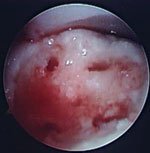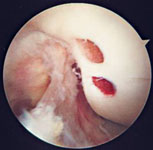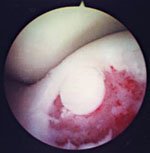Microfracture, OATS found effective for capitellum OCD lesions in adolescents
Postoperative return to sports was possible for all patients regardless of which treatment they had.
Investigators from the Kerlan-Jobe Orthopaedic Clinic in Los Angeles found athletes with elbow osteochondritis dissecans lesions treated with two different arthroscopic techniques returned to their previous levels of sports competition.
The physicians retrospectively analyzed results of arthroscopic treatment for the osteochondritis dissecans (OCD) lesions with either microfracture or the osteochondral autograft transfer system (OATS).
“Excellent clinical results and excellent return to previous level of competition was seen with microfracture of osteochondritis dissecans of the capitellum at early follow-up. At long-term follow-up, good clinical results and excellent return to previous level of competition were observed with OATS for lateral OCD lesions of the capitellum,” Jonathan D. Chappell, MD, said.
Surgical log reviewed
Chappell presented results of the study at the American Orthopaedic Society for Sports Medicine 2008 Annual Meeting. Neal S. ElAttrache, MD, a co-investigator with Chappell, performed the surgeries over a 10-year period.
|
|
Baseball was the predominant sport played by study participants.
For the surgical-log review Chappell and ElAttrache analyzed how the patients fared clinically and with regard to return-to-sport after arthroscopic treatment of OCD lesions of the capitellum.
All patients were placed in a supine position. In each case ElAttrache identified the OCD lesion and performed a local debridement. Based on the lesion location, the patient underwent microfracture if the lesion was located centrally on the capitellum or the OATS procedure if it was more laterally situated and engaged the radial head.
Baseball players
The microfracture group consisted of 11 patients whose average lesion size was 130 mm2. The average age for the entire group was 16.5 years; 10 patients were right-hand dominant and right elbows were involved in nine cases.
|
|
|
|
|
Images: Chappell JD |
At an average follow-up of 36 months, all patients who underwent microfracture treatment had 100% excellent results based on their clinical scores, Chappell said. “All 11 [patients] returned to their previous level of competition,” he said.
Flexion contracture decrease
Five patients underwent treatment with the OATS procedure for which ElAttrache used grafts harvested from the ipsilateral knee area.
The OATS groups’ overall clinical score was nearly as good as the microfracture groups’ scores. “Three of five had excellent results,” Chappell said. One patient each had good and fair results, but they all returned to their previous level of competition.
Follow-up averaged approximately 5 years for the OATS group.
The investigators found that postoperative range of motion increased in the microfracture group. “We found a statistically significant decrease in flexion contracture after surgery,” Chappell said. Although these measures changed between pre- and postoperative time points in the OATS group, the changes were not as great in the microfracture group.
No serious complications occurred with either procedure, Chappell noted. “This is early clinical follow-up of the microfracture treatment and long-term results are needed,” he said. “Additionally the OATS is a technical operation for select patents when the lateral column is involved.”
For more information:
- Jonathan D. Chappell, MD, can be reached at Wake Orthopaedics, 3009 New Bern Ave., Raleigh, NC 27610; 919-452-4258; e-mail: jonathanchappell@hotmail.com. He has no direct financial interest in any products or companies mentioned in this article.
Reference:
- Chappell JD, ElAttrache NS. Clinical outcome of arthroscopic treatment of OCD lesions of the capitellum. Presented at the American Orthopaedic Society for Sports Medicine 2008 Annual Meeting. July 10-13, 2008. Orlando, Fla.





